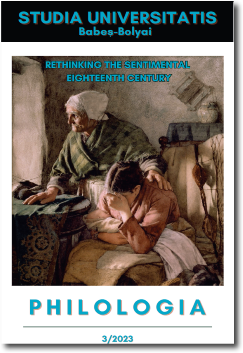JANE AUSTEN’S NORTHANGER ABBEY AS A PARODY OF SENTIMENTAL AND GOTHIC NOVELS
DOI:
https://doi.org/10.24193/subbphilo.2023.3.11Keywords:
Jane Austen, Northanger Abbey, sentimental novels, Gothic novels, Bildungsroman, parody, moral philosophyAbstract
Jane Austen’s Northanger Abbey as a Parody of Sentimental and Gothic novels. Jane Austen is one of the most outstanding British literary figures of the early nineteenth-century. In my article, I attempt to interpret her first completed novel, Northanger Abbey, regarding moral-philosophical, aesthetic and literary motifs. I would like to emphasize why it is advisable to read the novel both as a Bildungsroman and as a parody of sentimental and Gothic novels. In my opinion, in Northanger Abbey, Austen shows both the similarities and differences between sentimental and Gothic novels in such a way that she wants to break out of their usual patterns. In Austen's works, the heroines need to get to know new places and people in order to re-evaluate their perspective. In addition, they must learn to face their mistakes and their consequences. What makes the heroine of Northanger Abbey even more relevant for the proposed reading is that her personality traits are apparently created by denying the characteristics of the idealized heroines of sentimental and Gothic novels. Furthermore, from the way Jane Austen closes her story, we can conclude that she rejects the conventions of Gothic and sentimental novels and makes explicit the possible psychological reading of female Gothic novels and at the same time she rewrites romantic literature and even the conventions of the female Gothic novel ending.
REZUMAT. „Northanger Abbey” de Jane Austen: o parodie a romanelor sentimentale și gotice. Jane Austen este una dintre cele mai remarcabile figuri literare de la începutul secolului al XIX-lea britanic. În acest articol, îmi propun să analizez primul său roman adus la bun sfârșit, Northanger Abbey, din perspectiva motivelor sale filosofice, estetice și literare. Voi încercă să subliniez de ce acest roman trebuie înțeles atât ca Bildungsroman, cât și ca parodie a romanelor sentimentale și gotice. În opinia mea, în Northanger Abbey, Austen scoate la iveală similaritățile și diferențele dintre romanele sentimentale și gotice cu scopul de a depăși convențiile acestora. În scrierile lui Austen, eroinele sunt nevoite să întâlnească persoane și să vadă locuri noi pentru a-și interoga propria perspectivă asupra lumii. Mai mult decât atât, sunt forțate de împrejurări să își recunoască greșelile și să suporte consecințele. Ceea ce o face pe eroina romanului Northanger Abbey cheia unei astfel de lecturi este faptul că este înzestrată cu trăsături care se opun celor ce aparțin în mod tradițional eroinelor idealizate din romanele sentimentale sau gotice. În plus, din modul în care Jane Austen își aduce la bun sfârșit povestea, putem trage concluzia că ea respinge convențiile romanelor gotice și sentimentale și că face posibilă o lectură psihologică a romanelor gotice scrise de femei, dar și că rescrie literatura romantică împreună cu convențiile legate de modul în care se termină în mod obișnuit romanele gotice scrise de femei.
Cuvinte-cheie: Jane Austen, Northanger Abbey, romane sentimentale, romane gotice, Bildungsroman, parodie, filosofie morală
Article history: Received 31 May; Revised 25 August 2023; Accepted 12 September 2023; Available online: 30 September 2023; Available print: 30 September 2023.
References
Austen, Jane. 1903. Northanger Abbey. Cambridge: University Press.
Braudy, Leo. 1973. “The Form of the Sentimental Novel.” NOVEL: A Forum on Fiction 7, no. 1: 5-13.
Buckley, J. H. 1974. Season of Youth: The Bildungsroman from Dickens to Golding. Cambridge: Harvard University Press.
Deczki, Sarolta. 2019. “A másik nő. A nevelődés regény női változatai a kortárs magyar irodalomban.” In Női reprezentációk, 103-10. Debrecen: Debreceni Egyetemi Kiadó.
Dilthey, Wilhelm. 1985. Poetry and Experience. Princeton: Princeton University Press.
Gallon, D. N. 1968. “Comedy in ‘Northanger Abbey’.” The Modern Language Review 63, no. 4: 802-09. Modern Humanities Research Association.
Ghoshal Wallace, Tara. 1988. “Nothanger Abbey and the Limits of Parody.” Studies in the Novel 20, no. 3: 262-73.
Hume, Robert D. 1969. “Gothic versus Romantic: A Revaluation of the Gothic Novel.” PMLA 84, no. 2 (March): 282-90.
Macintyre, Alasdair. 2007. After Virtue: A Study in Moral Theory. Indiana: University of Notre Dame Press.
Mathison, John K. 1957. “Northanger Abbey and Jane Austen's Conception of the Value of Fiction.” ELH 24, no. 2 (June): 138-52.
Rivero, Albert J. (ed.). 2019. The Sentimental Novel in the Eighteenth Century. Cambridge: Cambridge University Press.
Schorer, Mark. 1956. “Pride Unprejudiced.” The Kenyon Review 18, no. 1 (Winter): 72-91.
Séllei, Nóra. 2015. Lánnyá válik, s írni kezd – 19. századi angol írónők. Debrecen: Debreceni Egyetem Kiadó.
Shaw, Narelle. 1990. “Free Indirect Speech and Jane Austen's 1816 Revision of ’Northanger Abbey’.” Studies in English Literature, 1500-1900 30, no. 4: 591-601.
Shields, Carol. 2007. Jane Austen. Íjgyártó Judit ford. Budapest: Ulpius-ház.
Smith, Nelson C. 1973. “Sense, Sensibility and Ann Radcliffe.” Studies in English Literature, 1500-1900 13, no. 4 (Autumn): 577-90.
Downloads
Published
How to Cite
Issue
Section
License
Copyright (c) 2023 Studia Universitatis Babeș-Bolyai Philologia

This work is licensed under a Creative Commons Attribution-NonCommercial-NoDerivatives 4.0 International License.





 ©Studia Universitatis Babeş-Bolyai Philologia. Published by Babeș-Bolyai University.
©Studia Universitatis Babeş-Bolyai Philologia. Published by Babeș-Bolyai University.